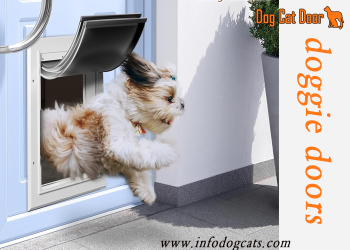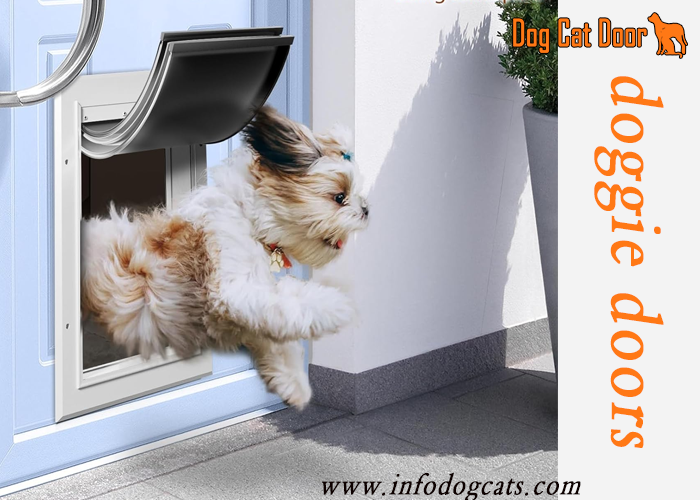learn more about Doggie Doors Your Ultimate Guide to Freedom for Your Dog. Are you tired of constantly getting up to let your dog in or out? Doggie doors are the perfect solution! They give your furry friend the freedom to roam as they please without needing you to play doorman. Whether you have a tiny pup or a big dog, there’s a doggie door that can suit your needs perfectly. But how do you choose the right one? Let’s dive into everything you need to know about doggie doors.
What Are Doggie Doors?
Simply put, doggie doors are small entryways installed in a door or wall, allowing your pet to move freely between the indoors and outdoors. They come in various designs, from basic flap-style doors to high-tech automatic ones. Installing a doggie door can drastically improve your dog’s quality of life, giving them more independence while making your life a lot easier too.
Why Choose a Doggie Door for Your Pet?
Wondering why you should install a doggie door? Here’s the answer: It’s all about freedom for your pet and convenience for you. Imagine never having to rush home to let your dog outside or having your morning routine interrupted by an impatient pup scratching at the door. Doggie doors let your dog take care of their needs on their own, making them happier and more self-reliant.
Plus, if you’re a pet owner with a busy lifestyle, a doggie door can help reduce accidents in the house by giving your dog access to the outdoors when they need it. Sounds good, right?
Types of Doggie Doors
Not all doggie doors are created equal. There are several different types, each with its own benefits and considerations. Let’s explore the most common types of doggie doors.
1. Traditional Flap Doggie Doors
The traditional flap door is probably the first thing that comes to mind when you think of doggie doors. This simple, cost-effective option involves a flexible flap that your dog pushes through to go outside. These doors are easy to install and affordable, but they may not be the best for homes in extreme climates, as they can let in drafts.
2. Electronic Doggie Doors
Want a smarter, more secure solution? Electronic doggie doors are equipped with sensors that communicate with a collar your dog wears. This ensures that only your pet can enter or exit through the door. They offer added security by keeping out stray animals, but they tend to be more expensive and require batteries or electricity to function.
3. Sliding Glass Doggie Doors
Do you have a sliding glass door? There’s a doggie door for that! Sliding glass doggie doors fit into your existing sliding door track, making them easy to install without any major modifications to your home. They’re a great temporary solution for renters or anyone who doesn’t want to cut into their door or wall.
4. Wall-Mounted Doggie Doors
If you prefer not to install the doggie door in your main door, wall-mounted options provide flexibility in placement. These doors are installed through an exterior wall, giving you the freedom to place the pet door anywhere in your home. However, installation can be a bit more complex, and it may require professional assistance.
5. Magnetic Doggie Doors
Magnetic doggie doors are a hybrid option that adds some insulation to the traditional flap door design. Magnets help keep the door closed when not in use, providing better insulation from the weather outside. These doors are a great middle ground between simple and high-tech options, but some timid dogs may need encouragement to push through the magnetic seal.
Benefits of Installing Doggie Doors
Installing a doggie door offers a wide range of benefits. Here’s a quick rundown of why you and your pet will love having one.

1. Convenience for Pet Owners
Let’s face it—getting up every time your dog wants to go outside can get exhausting. A doggie door takes that responsibility off your hands, giving your pet the freedom to go outside whenever they need to.
2. Independence for Your Dog
Doggie doors allow your pet to roam freely, which can reduce their anxiety and make them feel more independent. Dogs enjoy having access to the outdoors, especially if they have a yard to play in.
3. Fewer Indoor Accidents
For puppies or senior dogs that need frequent bathroom breaks, a doggie door can be a lifesaver. It helps reduce the likelihood of accidents inside your home, giving your pet a way to relieve themselves when nature calls.
4. Energy Efficiency
Many modern doggie doors are designed with insulation in mind, helping to maintain your home’s energy efficiency. Insulated or magnetic doors can prevent drafts from coming in during the colder months.
5. Safety and Security
Worried about unwanted critters or intruders coming through the doggie door? Electronic options only open for your pet, ensuring that no unwanted guests can enter your home. Some models even come with locking mechanisms for added peace of mind.
How to Choose the Right Doggie Door for Your Home
When choosing the right doggie door, there are a few key factors to consider.
1. Size of Your Dog
The size of the doggie door should match the size of your pet. Measure your dog’s height from their shoulders to the ground, and choose a door that’s slightly taller than that measurement. Make sure your dog can comfortably pass through without having to crouch or squeeze.
2. Location and Installation
Think about where you want to install the doggie door. If it’s going into a door, make sure the material is easy to modify. If it’s going into a wall, you may need professional help to ensure the installation is done correctly.
3. Security Concerns
If you’re concerned about security, an electronic doggie door may be your best bet. These doors ensure that only your dog can access the door, keeping out other animals and unwanted intruders.
4. Weather Resistance
If you live in a region with extreme weather conditions, look for a doggie door with good insulation. Magnetic or double-flap models can help keep cold drafts and rain from entering your home.
5. Budget
There’s a doggie door for every budget, from affordable manual flap doors to high-tech electronic models. Choose the door that offers the best value for your money while meeting your needs and your dog’s requirements.
Installation Tips for Doggie Doors
Ready to install your doggie door? Here are some quick tips to make the process smoother:
- Measure Twice, Cut Once: Always measure your dog and the door carefully before cutting into any material.
- Use the Right Tools: A jigsaw is commonly used for cutting holes in doors or walls. Make sure you have the proper tools for the installation.
- Follow Instructions: Each doggie door comes with its own set of installation instructions. Read them carefully and follow them step-by-step.
- Consider Professional Help: If you’re installing a wall-mounted doggie door or an electronic model, it might be worth hiring a professional to ensure everything is done correctly.
Training Your Dog to Use a Doggie Door
If your dog has never used a doggie door before, training might take a little time. Here’s how to do it:
- Start Slowly: Prop the door open at first so your dog can get used to passing through without having to push the flap.
- Use Treats: Encourage your dog with treats or their favorite toy to lure them through the door.
- Positive Reinforcement: Praise and reward your dog whenever they successfully go through the doggie door. With time, they’ll get the hang of it.
Is a Doggie Door Right for Your Pet?
At the end of the day, installing a doggie door can be one of the best decisions you make for both you and your dog. It offers convenience, independence, and reduces the hassle of constant door duty. However, it’s essential to choose the right type of doggie door based on your dog’s size, your home’s layout, and your security concerns. Whether you opt for a traditional flap, a high-tech electronic door, or something in between, the freedom it gives your dog will be worth it. Ready to give your pet the independence they crave?
FAQs About Doggie Doors
1. Can a doggie door be installed in a wall?
Yes, wall-mounted doggie doors are a popular option for homeowners who prefer not to modify an existing door. However, these installations may require professional help.
2. Are doggie doors safe from intruders?
Some doggie doors, especially electronic ones, come with features to enhance security, such as sensors that only open for your pet or locking mechanisms.
3. How do I train my dog to use a doggie door?
Use treats and positive reinforcement to encourage your dog to go through the door. Start by propping the door open and gradually train them to push the flap on their own.
4. Do doggie doors affect home insulation?
Poorly designed doggie doors can let in drafts, but there are insulated and magnetic options available that help maintain your home’s energy efficiency.
5. Can I install a doggie door myself?
Yes, many doggie doors can be installed by the average DIYer, but more complex models or wall-mounted doors may require professional installation.

